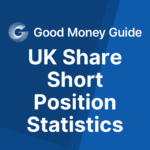What are Leveraged Shares?
Financial markets are full of innovation and are always evolving as a result, and that evolution often means the introduction of new products and ways of trading. Which these days are usually available to private clients straight off of the bat. Recent innovations include commission-free dealing, fractional share ownership, and most recently leveraged shares.
Leveraged shares are not actually shares at all, what they are, are single name leveraged ETFs, which of course means that they are ETPs or Exchange-Traded Products rather than vanilla ETFs.
These leveraged shares work in a similar way to other leveraged and inverse leveraged ETFs, that is they are instruments that are designed for short-term daily trading as they have an end of day reset feature, so they are not suited to buy and hold or other medium to longterm trading strategies.
Currently, leveraged shares are currently available in 4 flavours which are 2 or 3 times leveraged on the long side and -1 or -3 times leveraged on the short or inverse side.
These single stock leveraged ETPs are available on a range of US equities, mostly names from the tech sector but there are also a number of UK blue chips with both long and inverse ETFs available with three times leverage.
Here is how to buy shares in any company from any stock exchange.
How and where can you buy leveraged shares
Though they are complex products these single stock ETPs are listed on the London Stock Exchange meaning that in theory they could be traded by all UK stockbrokers, so it will be worth checking with your existing provider. However, if they don’t offer these instruments leverage shares kindly provide a list of brokers who do. See this link
The major risks of leveraged shares
Trading with leverage allows you to increase your exposure to the market for the same amount of outlay or investment than you would be able to achieve without leverage, giving you more bang for your buck as it were.
However, leverage also magnifies trading PnLs – magnifying not only trading profits but also trading losses just as efficiently. Traders need to respect and understand the use of leverage and factor it into their trading strategy.
Derivative products of which Single Stock ETPs are an example are generally designed to allow traders to offset risk and facilitate diversification or hedging. However, they can of course be used to concentrate or increase risk, and that’s something that all traders need to be aware of.
The key benefits of buying leveraged shares
The biggest benefit that leveraged shares offer to traders is the ability to allocate assets quickly and to jump on trends within actively traded instruments, stocks such as Apple, Amazon and Tesla (NASDAQ:TSLA) can experience dramatic intraday moves and trading those moves using leveraged shares can amplify them greatly.
So, for example, If you notice that a US tech stock is called to open up +2% pre-market but you believe that the stock can run further over the course of the day. Then you might choose to buy the 3 times levered signal stock ETP on that name.
If the underlying tech stock adds another +4% during the course of the day then you will have effectively captured a +12% move. That is the additional +4% move in the stock multiplied by the leverage factor contained in the ETP, in this case, three.
- Related guide: Can you use shares in your portfolio as collateral for CFD trading and spread betting?
To have achieved a similar outcome trading the underlying stock you would have to have traded in three times as many shares with obvious implications for cost and exposure etc. associated with high priced US names.
What can you trade-in with leveraged shares?
Right now there are two providers of leveraged ETPs which are Leverage Shares and Granite Shares both are US ETF providers but their products are listed here in London on the LSE as the UK regulator is more open to narrow leveraged products than its US peers.
As noted above there are a host of US tech names available alongside a short dozen UK blue chips including:
| Three times leveraged shares | Two times leveraged shares |
Inverse leverage shares
|
| 3x Alphabet ETP | 2x Advanced Micro Devices ETP |
-1x Advanced Micro Devices ETP
|
| 3x Amazon ETP | 2x Alibaba ETP | -1x Alibaba ETP |
| 3x Apple ETP | 2x Alphabet ETP |
-1x Alphabet ETP
|
| 3x Facebook ETP | 2x Amazon ETP |
-1x Amazon ETP
|
| 3x Microsoft ETP | 2x Apple ETP | -1x Apple ETP |
| 3x Netflix ETP | 2x Citigroup ETP |
-1x Facebook ETP
|
| 3x NVIDIA ETP | 2x Facebook ETP |
-1x Micron Technology ETP
|
| 3x Salesforce.com ETP | 2x Goldman Sachs ETP |
-1x Microsoft ETP
|
| 2x JPMorgan ETP | -1x Netflix ETP | |
| 2x Micron Technology ETP | -1x NVIDIA ETP | |
| 2x Microsoft ETP |
-1x Salesforce.com ETP
|
|
| 2x Netflix ETP | -1x Tesla ETP | |
| 2x NVIDIA ETP | -1x Twitter ETP | |
| 2x Salesforce.com ETP | -1x Uber ETP | |
| 2x Tesla ETP | ||
| 2x Twitter ETP | ||
| 2x Uber ETP | ||
| 2x Visa ETP |
Shorting the market with leveraged shares
In the third column of the above table, it shows the leveraged shares which enable you to short the market. Inverse leverage shares go up when the underlying stock goes down and up when they go down. Inverse leverage shares allow you to essentially short a stock by buying an on exchange security.
How ETPs differ from ETFs
The key difference between ETFs and ETPs are the use of leverage and the short-term nature of ETPs. whilst ETFs look and behave in a similar way to mutual funds. However, if we lift the hood on ETPs we discover that they are effectively a series of swap arrangements between the ETP issuer and an investment bank. In the case of the Granite Shares products their swap counterparty is the French bank Natixis
The difference between buying leveraged shares and margin trading CFDs
The principle difference is that when you trade using CFDs your trading account is leveraged rather than the product. Whilst in the case of single stock leveraged ETP it is the product that is leveraged, which means that you just pay the purchase price of the ETP rather than putting an initial margin or deposit down as you do when you trade with a CFD.
There are also separate instruments in the ETP world for going long or short whereas when you trade a CFD you trade one instrument but in different directions. CFDs can offer traders the opportunity to trade in smaller contract sizes than the standard lot sizes that underlying instruments trade in, on-exchange, where the typical minimum size is one lot or share.
Finally, and perhaps most importantly of all equity CFDs have no fixed expiry date and provide a delta 1 return on the underlying price during their lifetime. Single stock leveraged ETPs do not have an expiry date either, however, they do reset daily and are not suitable for anything other than trading over the course of a business day.

With over 35 years of finance experience, Darren is a highly respected and knowledgeable industry expert. With an extensive career covering trading, sales, analytics and research, he has a vast knowledge covering every aspect of the financial markets.
During his career, Darren has acted for and advised major hedge funds and investment banks such as GLG, Thames River, Ruby Capital and CQS, Dresdner Kleinwort and HSBC.
In addition to the financial analysis and commentary he provides as an editor at GoodMoneyGuide.com, his work has been featured in publications including Fool.co.uk.
As well as extensive experience of writing financial commentary, he previously worked as a Market Research & Client Relationships Manager at Admiral Markets UK Ltd, before providing expert insights as a market analyst at Pepperstone.
Darren is an expert in areas like currency, CFDs, equities and derivatives and has authored over 260 guides on GoodMoneyGuide.com.
He has an aptitude for explaining trading concepts in a way that newcomers can understand, such as this guide to day trading Forex at Pepperstone.com
Darren has done interviews and analysis for companies like Queso, including an interview on technical trading levels.
A well known authority in the industry, he has provided interviews on Bloomberg (UK), CNBC (UK) Reuters (UK), Tiptv (UK), BNN (Canada) and Asharq Bloomberg Arabia.
You can contact Darren at darrensinden@goodmoneyguide.com



